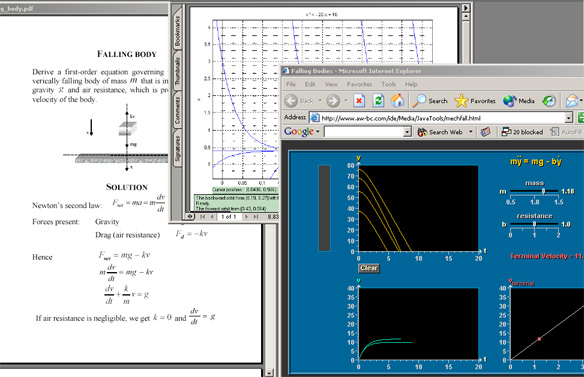|
|
|
|||||||||||||||||
|
|||||||||||||||||
|
|
| Public use of technology | ||||||||
|
I used electronic presentations quite a number of times in my Differential Equations classes. The material in these classes is conducive to the use of technology, especially when it comes to applications and graphical representation of data. For example, whenever subject calls for drawing direction fields, I would use computer and projector in class to demonstrate the use of MATLAB dfield6 program. Students are usually very excited in these sessions since they know these are the kinds of exercises they will be asked to complete at home when working on their homework assignments. The use of computer makes it possible to answer students' questions without prior preparation, in "interactive mode", so to speak. This addresses the first question I would like to raise.
Why not use transparencies or other forms of still graphics, one might ask? In my opinion, one clear advantage electronic presentations possess is interactivity. Apart from what has been said earlier, you can also easily take control of the data flow, highlight important things and hide statements you want to show later. Electronic software now offers lots of intelligent ways of organizing one's presentation without going into a necessity of covering part of a transparency with a piece of paper. And let us not forget animations, which would be impossible to reproduce in any way other than by use of computer software. What does it have to do with teaching mathematics? Let me share some of my personal experience here. I used to do everything on the board with a couple of occasional transparencies. I still dedicate a lot of time to blackboard exercises, but I found that it really helps to take a little break, switch to the electronic materials I have at hand and review important concepts or involve students in analysis of an interactive applet. For example, in my Math251 class when explaining dropping body application, I would load this web applet. We would then go on to discuss the profiles of velocity and position versus time and discover the phenomenon of terminal velocity. After that I would proceed with solving underlying problem on the board and show why indeed such phenomenon takes place. The applet makes the situation really intuitive for the students, so their visual memory and physical experience help them in understanding of the problem and let them avoid the mistakes they would be inclined to make otherwise. It would take me enormous amount of time to stage a similar experiment without technology. Below is a sample screen capture from such a presentation. 
Simulations are not the only purpose I use presentations for. I believe most students learn better by repetition, that is, when important concepts are demonstrated over and over again. But how can a teacher organize the material in such a way so as to ensure the students are keeping up with the new topic, dedicate enough time to reviewing old material and still manage to keep the consistency of the course structure? I guess there is no unique answer, the problem of time is universal for all of us, so everyone does what works best for them. I must confess this is still a big issue for me, since you can never predict how students will react to this or that concept, so you end up spending a week explaining things you thought would fit into one lecture. Since I know by experience that such things do happen, I try to save time whenever I can. One thing I found useful is doing a short review at the end of each chapter to summarize the material and identify potential problems before moving to the new topic. I would make some Powerpoint slides to complement the material of a chapter and would go over them in class. Since all materials are available in electronic format, it saves my time and students focus more on the issues being reviewed rather than on copying them to their notebooks. Here are the presentation files in Powerpoint format: Math250Chap1(197K) and PDF format: Math250Chap1(152K) With all its power technology does have its drawbacks. The major source of troubles for me is the equipment. Some of the rooms I've taught in didn't have all necessary equipment installed, so I had to bring missing items with me every time and make sure they're all connected properly before class starts. Easy as it is, this can be really frustrating in case something goes wrong, so you always need a backup plan. Even in fully equipped rooms there were situations when projector would simply refuse to work. I've never had a chance of teaching in so-called student technology classrooms, where there are as many computers as there are students, but I can imagine it being an even more stressful environment, since instructor is now responsible for the efficient work of the whole class. The scheme that works best in my opinion is a combination of different teaching strategies, from traditional lecture style teaching to computerized presentations, collaborative problem solving and complex technology-aided group projects. In my opinion, good use of technology is a moderate use of technology, so I alternate all these techniques in order to maximize the efficiency of the overall presentation and to minimize the risk each one of them carries.
|
||||||||
|
[Innovative technologies] [Reflection on teaching] [Courses I taught] [Personal webpage] Best viewed with Internet Explorer 4.0 and above 
|